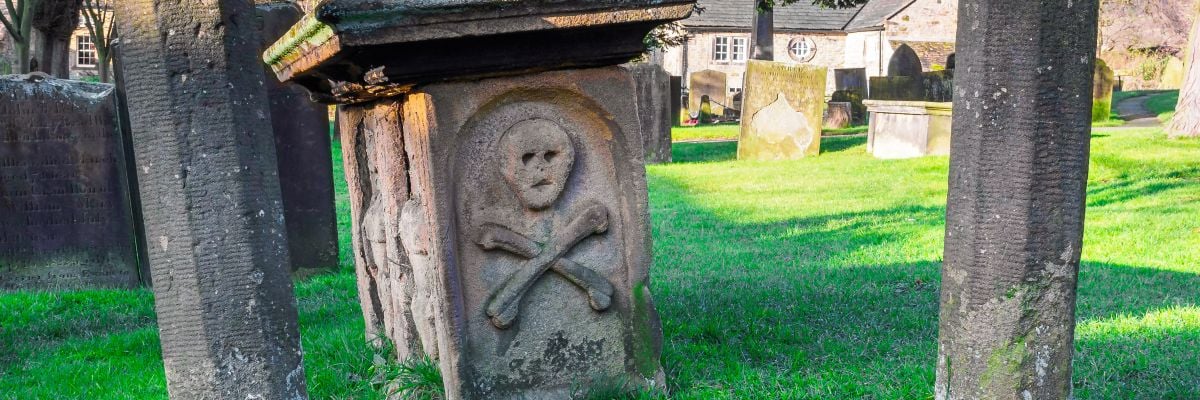
As the modern world struggles to handle the impact of the Coronavirus/Covid-19 pandemic, commentators are making comparisons to previous viral outbreaks such as the Influenza Pandemic (or “Spanish Flu”) in the early twentieth century or the Black Death in the fourteenth century. Although historical comparisons can be helpful in some situations, they are not always beneficial because the context in which these events occurred is often not sufficiently acknowledged.
The Black Death is one of the best-known calamities in human history, but the society it ravaged and its impacts on Christendom and the Church are not widely understood. Given the current health crisis gripping the modern world, it may be profitable to investigate the period in an effort to shed a different light on the current situation.
In the mid-fourteenth century, a nasty virus carried to Europe by merchants from the East attacked Christendom. Known at the time as “the pestilence,” “the plague,” or “the great mortality” (the term “Black Death” was coined first in the sixteenth century but entered popular usage in the nineteenth century), it began in China, spread to Mongolia, the Byzantine Empire, and the Crimea, from which it entered Sicily and spread throughout Europe. Every country in Christendom was affected except Poland and Bohemia, which had limited merchant activity with the rest of Europe.
England suffered greatly from three waves of the plague over the course of a century. So great the devastation that the country did not return to its pre-plague population of six million until the mid-eighteenth century.
The deadly pestilence occurred in three forms: bubonic, septicemic, and pneumonic plague. Bubonic plague produced painful buboes in the lymph nodes, especially in the groin, armpits, and neck. Symptoms included high fever, swelling of the lymph nodes, diarrhea, vomiting, headaches, convulsions, and dizziness. The septicemic plague involved an infection of the blood and produced black and blue marks on the body, abdominal pain, and other symptoms. The pneumonic plague produced shortness of breath, chest pain, and coughing as the infection settled in the lungs.
Medieval doctors did not have accurate knowledge of the transmission of germs and immunology, so a wide spectrum of treatment options was employed, including enemas and bloodletting. Some doctors endorsed abstinence from seafood, sexual activity, and bathing. Jacme D’Agramont, a Spanish physician and professor at the University of Lerida, wrote in his book Regimen of Protection against Epidemics that, “habitual bathing is also very dangerous, because the bath opens the pores of the body and through these pores corrupt air enters and has a powerful influence upon our body.”
Although the plague affected parts of Europe differently, recent estimates put the overall death rate at fifty percent of Christendom’s total population over a two-year period. Cities were devastated and many urban dwellers fled to the countryside in an attempt to escape the pestilence. The volume of deaths was staggering as thousands died daily. In the Burgundian village of Givry the annual death rate before the plague was forty; in 1348, the village lost 650 souls. The southern French city of Avignon, home at this time to the popes, witnessed 11,000 deaths over a five-week period. The calamity produced extreme reactions. Some people believed the plague was punishment from God for the sins of humanity, so they publicly practiced extreme penances, such as scourging. A group known as the Flagellants developed. They preached doctrinal errors and ran afoul of the Church hierarchy because of their unorthodox and unauthorized preaching and penitential processions. The chronicler Heinrich of Herford recorded their vicious flagellations and wanderings from place to place:
I have seen, when they whipped themselves, how the iron points became so embedded in the flesh that sometimes one pull, sometimes two, was not enough to extract them. They wandered the land… but when they came to cities, towns, and large villages and settlements, they marched down the street in procession, with their hoods or hats pulled down a little to cover their foreheads.
The Flagellants required members to pledge not to leave the fraternity without permission of superiors, to practice silence, never to scourge themselves to the point of illness or death, to give alms to the poor, and to pray for an end to the pestilence. The people generally viewed the Flagellants favorably due to their overall appearance of piety and extreme penances. The Church, however, found the Flagellants independent streak troublesome and their unorthodox preaching unacceptable. Pope Clement VI (r. 1342–1352) suppressed the group in 1349 in the bull Inter Solicitudines.
In searching for an explanation for the outbreak of the plague, some Christians blamed the Jewish people. Rumors circulated in southern France and Spain, where the majority of Europe’s Jews lived, that the Jews had poisoned wells with the plague. Sadly, these rumors led to pogroms, mostly in German areas, in the fall of 1348, eventually encompassing nearly a hundred cities and towns by 1351. During the violence, Jews were burned, robbed, expelled, and forced to convert to the Christian Faith in order to spare their lives. Some Jews chose immolation and other forms of suicide rather than suffer at the hands of the mobs.
The Jewish community in Strasbourg suffered greatly as 900 Jews out of a population of 1,884 were killed. In some areas, bishops protected the Jewish people from harm. Notably, the Jewish community in Avignon, site of the papal residence, did not suffer because of the plague due to papal protection. Additionally, Pope Clement VI issued the bull Sicut Judeis in July 1348 declaring the Church’s protection of Jews throughout Christendom. Pope Clement highlighted the false charge against the Jews about the plague:
It does not seem credible that the Jews on this occasion are responsible for the crime nor that they caused it, because this nearly universal pestilence, in accordance with God’s hidden judgment, has afflicted and continues to afflict the Jews themselves.
The impact of the great pestilence on Christendom was widespread. Europe suffered great economic turmoil as trade was reduced and society witnessed a severe shortage of laborers. Spiritually, people gravitated to the Faith and sought solace in prayer and the sacraments.
The Church lost nearly forty percent of its priests to the Black Death. Some towns saw the death of ninety percent of priests. The English clergy died at an alarming rate, including three archbishops of Canterbury in the span of a year. Monasteries suffered immensely as the plague wiped out entire religious communities. The high percentage of clergy deaths because of the plague produced a shortage of priests, which the Church tried to ameliorate by lowering the minimum age of ordination from twenty-five to twenty. Although understandable given the circumstances, this action produced a cadre of inexperienced, young, and poorly formed priests. The quality of the priesthood suffered and with it the Church as a whole, as ecclesiastical abuses became widespread in the fifteenth century, leading—many believe—to the Protestant Revolution in the sixteenth century.



